Are you looking for a simple, surefire way to grow bunching onions from seeds and never run out again? Then follow along with our step-by-step guide.
Bunching onion is a versatile little herb you can never have too much of. It is used to season everything from soups, stews, sauces, and all types of meats.
Even though it originated in the Far East, it now plays an integral part in many culinary cultures worldwide. It is easy to grow, as simple as placing the leftover stalk into a jar of water.
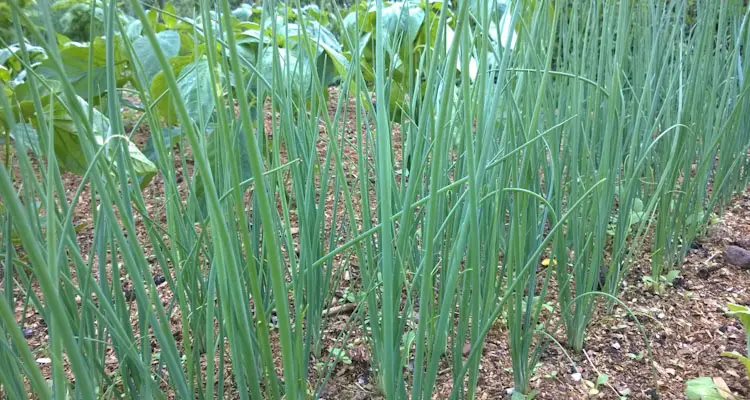
However, growing from seed makes a lot more sense due to the demand, especially if you wish to have an unlimited supply for years to come.
This post will show you a simple, easy-to-follow approach to planting and growing Bunching Onions from seed and a simple trick to keep them producing almost indefinitely.
Step 1: Collect Your Seeds And Other Planting Materials
Before you get started, there are a few items you will need. You should already have most of these but may need to purchase seeds and a few other pieces from your local garden center or online.
Here are the materials and equipment you will need to grow bunching onions from seeds.
| Item | Details |
| Bunching Onion Seeds | These might be labeled Scallion in your area. |
| Potting Mix | Preferably well-defined with little or no additional fertilizer. |
| Seedling Tray | 72 cells per tray, about 1″ size cells |
| Spray Bottle | A small 500ml plus with adjustable nozzle |
| Sealed Seed Tray | Larger enough for the seedling tray to fit. |
| Watering Can | Remember that each gallon (~4 liters) weighs about 10 lbs |
| Liquid Organic Fertilizer | View How To Make JLF for more info. |
| Compost / Mulch | Mulch will also help control weeds and provide suitable conditions for microbial activity. |
| Garden Hand Tools | Hand shovel, Hand Fork, Micro-tip Pruning Shears, Garden Fork & Shovel, etc. |
| Microorganism Solution | View How To Make JMS for more info. |
| Planter Box (Optional) | Or another suitable planting container |
| Sharp Knife | For harvesting leaves |
Note: Bunching onions can grow in relatively shallow containers, between 6 and 12 inches deep. So if you have limited space, be creative! You can purchase a beautiful planter or flower pot or use just about any food-safe container you can get your hands on. Just ensure it has enough drainage holes. Now, let's move on to the next step.
Step 2: Multi-Sow Seeds In Seedling Trays
There are many techniques you can use to sow your bunching onion seeds. However, I find that the Multi-Sow Technique is the most straightforward and efficient.
To use this technique, moisten the potting mix by gradually adding water to the media, mixing until it becomes fluffy with a dark color. It should be moist but not water-soaked.
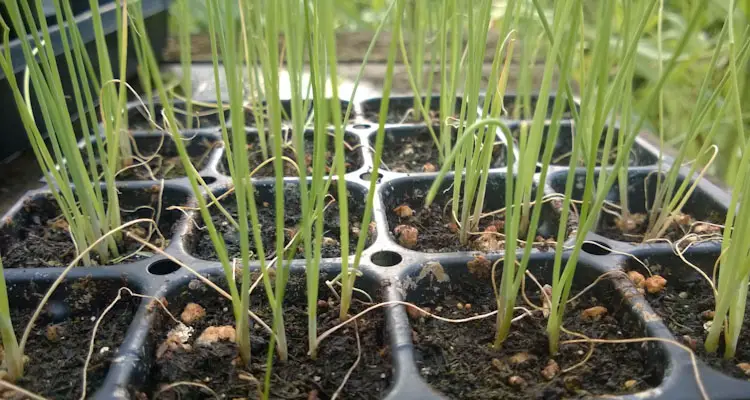
Fill the trays with the moist potting mix, leveling it off with your hands afterward. Then gently tap the bottom of the tray onto the table, allowing the media to settle to about ¼ inch from the top. Add more potting mix if necessary.
Place 3 to 5 bunching onion seeds into each cell. Don’t worry about overcrowding. We want to ensure that at least three seeds germinate in each cell. Besides, onions prefer to grow with neighbors.
Fill the tray with some more potting mix by creating a mound, then pressing gently. Remove the excess potting mix by carefully sliding your hand across the top of the tray, leveling it in the process.
Pour about 1” of water into the sealed tray or large container. Place the tray with the newly-sown seeds into this container, slowly letting the moisture wick to the surface.
Remover from the water, then cover with a large piece of cardboard and place into a cool, shaded area. You can stack trays on top of each other with the cardboard in between.
Step 3: Caring For Seedlings
Bunching onion seedlings typically takes between 5 and 7 days to germinate. However, this is affected by the temperature. So, you’ll need to monitor the trays carefully, especially if you live in a warm climate.
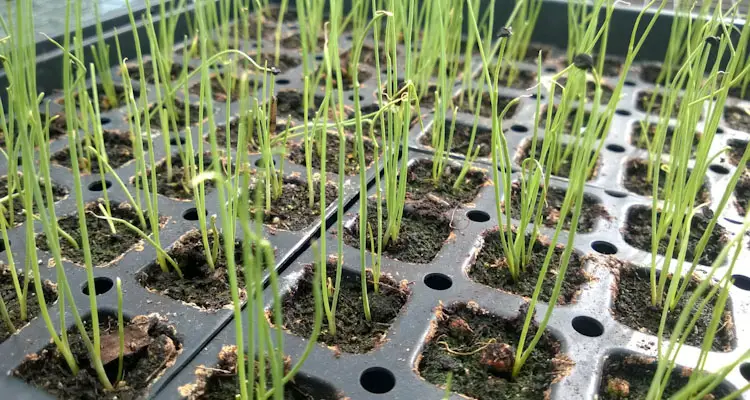
After germination, remove the trays under the cardboard and place them in a partially shaded area. Wait another week to ensure that all the seeds germinate. Place them in direct sunlight for a few hours in the morning to get them accustomed to the environment.
Monitor the potting mix for signs of drying out. Water from the bottom when necessary by placing the tray into a water container. At this stage, you may also water using a nozzle with the spray setting to avoid compacting the mix.
Apply diluted organic fertilizer about a week after all the seeds germinate. The seedlings should look like thin grasses now. Keep monitoring them for signs of drying out, watering only when necessary, and allow them to get full sunlight.
Thin the weaker seedlings, leaving about 3 per cell. You can use a micro-tip pruner to snip them at their base. Don’t worry if the others also look thin. That’s perfectly normal.
Continue to apply to dilute organic fertilizer weekly and water only when necessary. Allow it to dry out every once in a while.
The seedlings will be ready to transplant in about 6 weeks after germination. However, I prefer to wait until they stand firm since they tend to grow faster when transplanted at this stage.
Step 4: Prepare Garden Bed
Bunching onions are not picky about the soil type, so long as it is well-drained and allows the roots to grow freely. The ground should be full of organic matter to hold moisture since the plants have shallow roots.
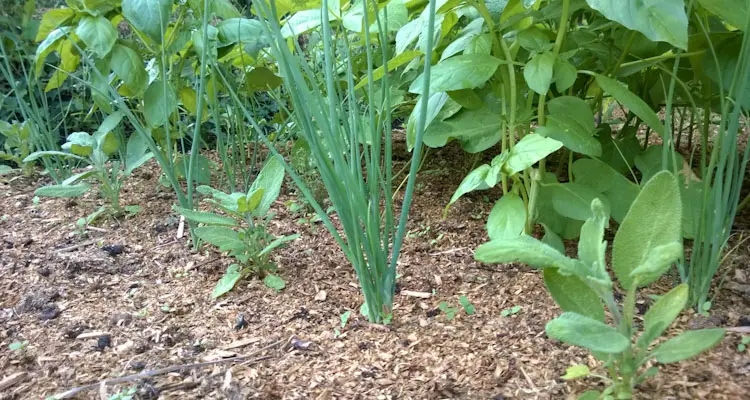
To prepare the soil, remove unwanted vegetation, then add a layer of active compost over the planting area. About ½ inch to an inch should be enough. Then add a layer of shredded mulching material.
Water the entire area thoroughly with a microbe amendment such as JADAM Microorganism Solution about 4 times a week before transplanting. The soil should become much softer within that time.
Note: The microbial activity in JMS has the additional benefit of balancing the soil’s PH while making nutrients and minerals available to the plant.
Step 5: Transplant And Care For Seedlings
Out of habit, I like to soak my seedlings in diluted organic fertilizer before transplanting. This is not necessary but seems to keep them healthy.
Remove the seedling plug from the tray and plant them in the garden or container about 4 inches apart. This equates to about 16 bunching onion plants using square foot gardening grid-like spacing.
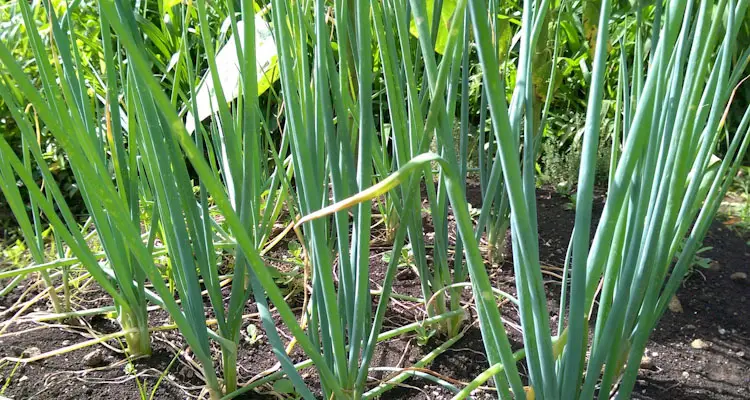
Water deeply with diluted JADAM Liquid Fertilizer, or one of the solutions outlined in the Nutritive Cycle Theory to lessen the severity of transplant shock.
Water daily for the first week, then gradually lessen the irrigation frequency to allow the plant to better acclimate to the environment.
You do not need to fertilize bunching onions much. However, after heavy rainfall, you may wish to apply some JLF, but remember, too much fertilizer might affect the intensity of the flavor.
Step 6: Harvest And Storage
Ideally, you can start to harvest bunching onions about 8 weeks after transplanting. However, feel free to harvest the outer leaves earlier if you need to use them in a dish.
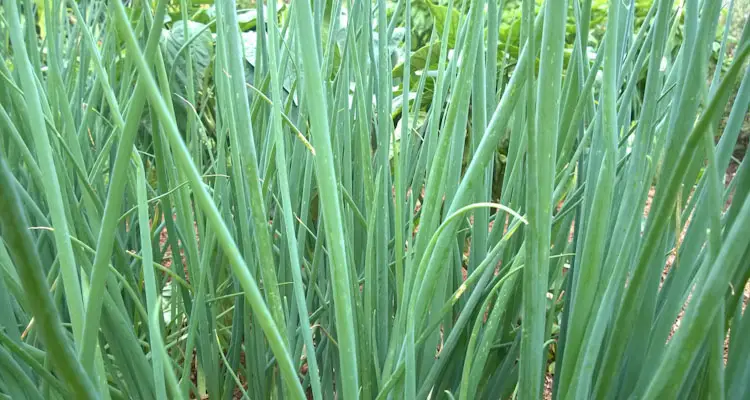
If harvesting Bunching onions for sale, you can gently separate individual stalks from the stool or uproot the entire stool and separate it afterward. Remove the excess dirt, roots, and any discolored leaves. Then rinse with water and package.
For personal use, you can continue to harvest the outer leaves from the bunching onion, removing individual stalks only when needed. This pruning keeps the plant healthy and stimulates additional bunching.
You can store bunching onions for up to a week in the refrigerator after harvesting. However, if you wish to keep it longer, you can freeze or dehydrate the freshly picked plant.
You can save and replant the roots of Scallions into water or some potting mix, and they will quickly grow into a new plant. Transplant them to an appropriate container after you see new growth.
Step 7: Collect And Dry Seeds (Optional)
Once you take care of your bunching onion plants, you will notice a swell at the tips about 3 to 4 months after transplanting. This indicates that it is about to flower and produce seeds.
The plant will continue to multiply at this stage, but the stalk with the flower does not have much flavor. Harvest the surrounding plants as usual, but allow the flowering stem to go to seed.
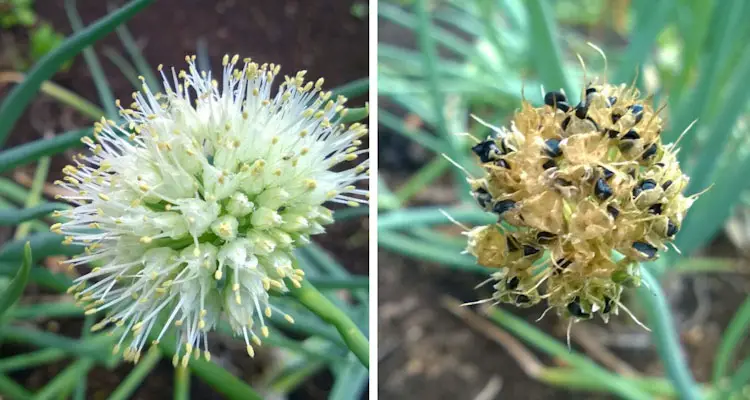
The flowers vary in color but are typically shaped like a spiked ball, which gradually darkens as it matures.
After some weeks, the flower will start to change color, and you will notice some black dots towards the tips. These are the seed pods.
Monitor the pods carefully for signs of opening. Once they do, you can cut the stalk, place a paper bag around it and hang it to dry in a sunny area. After about two weeks, most seeds will fall into the bag.
Remove the remaining seeds from the flower and allow them to dry for another week or two before removing the remaining straw-like covering.
Pour the seeds into an envelope, bottle, or storage container of your choice, and store them in a cool, dry place. The seeds can remain viable for two years or more. Test them occasionally.
Final Thoughts
Bunching onion is one of the easy herbs to grow, albeit a bit slow. It can be planted in limited space and does not take too long before harvest.
However, once it gets going, you can use it in almost any dish that asks for onions or mixed with other herbs to make a tasty, multipurpose Green Seasoning blend. I’m sure you can imagine the possibilities.
Just remember to plant the stalk or allow a stool to flower and produce seeds. Either way, you can have and enjoy Bunching onions for years.
Related Questions
Difference Between Bunching Onion And Green Onion.
Bunching onions, also known as Scallions, are varieties of plants in the Allium family that do not produce bulbs. While Green Onions usually refer to young onion plants which have not yet developed their bulbs. In other words, all Bunching onions can be classified as Green onions but not all green onions bunch.
References
The University Of California. Green Bunching Onions. mgsantaclara.ucanr.edu. Accessed June 2022
Johnny Seeds. Bunching Onion – Key Growing Information. johnnyseeds.com. Accessed June 2022

